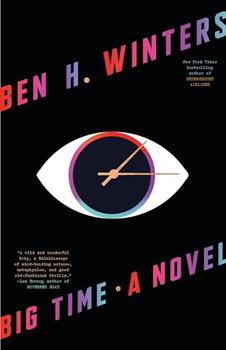Summary | Excerpt | Reviews | Beyond the book | Read-Alikes | Genres & Themes | Author Bio

Critics' Opinion:
Readers' Opinion:
First Published:
Nov 2012, 336 pages
Paperback:
Nov 2013, 336 pages
 Book Reviewed by:
Book Reviewed by:
Poornima Apte
Buy This Book
Once America's capitalist dream town, Detroit is our country's greatest urban failure, having fallen the longest and the farthest. With an eye for both the darkly absurd and the radically new, we glimpse a future Detroit that is smaller, less segregated, greener, economically diverse, and better functioning - what might just be the first post-industrial city of our new century.
Once America's capitalist dream town, Detroit is our country's greatest urban failure, having fallen the longest and the farthest. But the city's worst crisis yet (and that's saying something) has managed to do the unthinkable: turn the end of days into a laboratory for the future. Urban planners, land speculators, neo-pastoral agriculturalists, and utopian environmentalists - all have been drawn to Detroit's baroquely decaying, nothing-left-to-lose frontier.
With an eye for both the darkly absurd and the radically new, Detroit-area native and Rolling Stone writer Mark Binelli has chronicled this convergence. Throughout the city's "museum of neglect" - its swaths of abandoned buildings, its miles of urban prairie - he tracks the signs of blight repurposed, from the school for pregnant teenagers to the killer ex-con turned street patroller, from the organic farming on empty lots to GM's wager on the Volt electric car and the mayor's realignment plan (the most ambitious on record) to move residents of half-empty neighborhoods into a viable, new urban center.
Sharp and impassioned, Detroit City Is the Place to Be is alive with the sense of possibility that comes when a city hits rock bottom. Beyond the usual portrait of crime, poverty, and ruin, we glimpse a future Detroit that is smaller, less segregated, greener, economically diverse, and better functioning - what might just be the first post-industrial city of our new century.
Introduction
Back when I was a boy, growing up just outside of Detroit, my friends and I beheld any mention of the city in popular culture with a special thrill. We loved how Detroit was deemed terrifying enough to be chosen as the dystopian locale of RoboCop, the science fiction film set in a coyly undated "near future," when Detroit had become so dangerous that the outsourcing of law enforcement to an armored, heavily weaponized cyborg would seem a prudent and necessary move. And when the producers of Beverly Hills Cop decided to make the hometown of Eddie Murphy's fish-out-of-water detective our own—because, after all, what could be more antipodal to Rodeo Drive than Woodward Avenue, what more alien presence to the Beverly Palms Hotel than a black dude from Detroit in a Mumford High T-shirt?—we delighted in that, too. We certainly tested the speakers of our American-made Dodge hatchbacks whenever a Detroit song found itself played on one of the competing local rock ...
When Mark Binelli, a native of Detroit, and general assignment reporter, began work on a book about the city, one of his interview subjects asked him if the book was going to be fiction or non-fiction. “Non,” Binelli replied. Binelli writes about the guy’s reaction: "He snorted and said, ‘No one’s gonna believe it.'”
A large portion of Binelli’s engaging book, Detroit City is the Place to Be, covers the stuff that “no one’s gonna believe.”..continued
Full Review
(930 words)
This review is available to non-members for a limited time. For full access,
become a member today.
(Reviewed by Poornima Apte).
 Elmore Leonard
I like Mark Binelli's book a lot. He covers the shrinking of Detroit, its downfall from the lofty peak as Arsenal of Democracy, with clear, expository prose and no axe to grind. A firefighter asks the author, 'You going fiction or non-fiction?' Binelli answers, 'Non.' And the reply comes back, 'No one's going to believe it.'?
Elmore Leonard
I like Mark Binelli's book a lot. He covers the shrinking of Detroit, its downfall from the lofty peak as Arsenal of Democracy, with clear, expository prose and no axe to grind. A firefighter asks the author, 'You going fiction or non-fiction?' Binelli answers, 'Non.' And the reply comes back, 'No one's going to believe it.'? Kevin Boyle, author of Arc of Justice: A Saga of Race, Civil Rights and Murder in the Jazz Age
Let's face it. Detroit City is not the place to be. But if you care about America you have to see it, to walk its desolate streets, to talk to the people who make it their home, to hear what it means to live on the wrong side of the post-industrial divide. And you're not going to find a smarter, tougher, more entertaining guide than Mark Binelli. If you give a damn you've got to read this book.
Kevin Boyle, author of Arc of Justice: A Saga of Race, Civil Rights and Murder in the Jazz Age
Let's face it. Detroit City is not the place to be. But if you care about America you have to see it, to walk its desolate streets, to talk to the people who make it their home, to hear what it means to live on the wrong side of the post-industrial divide. And you're not going to find a smarter, tougher, more entertaining guide than Mark Binelli. If you give a damn you've got to read this book. Wells Tower, author of Everything Ravaged, Everything Burned
With the acuity of Joan Didion and the controlled hilarity of Ian Frazier, Mark Binelli investigates the portents and absurdities of America's most infamous urban calamity. Exhilarating in scope, irresistible for its intricate, scrupulous portraiture, Detroit City Is the Place to Be is the masterful performance of one of our generation's most humane and brilliant writers.
Wells Tower, author of Everything Ravaged, Everything Burned
With the acuity of Joan Didion and the controlled hilarity of Ian Frazier, Mark Binelli investigates the portents and absurdities of America's most infamous urban calamity. Exhilarating in scope, irresistible for its intricate, scrupulous portraiture, Detroit City Is the Place to Be is the masterful performance of one of our generation's most humane and brilliant writers. Even as Detroit City might be having a rejuvenation of sorts by attracting increasing numbers of artists, it is worth looking back to the Great Depression when a Mexican mural artist, Diego Rivera, created the city's most iconic art: the set of murals known as Detroit Industry.
Even as Detroit City might be having a rejuvenation of sorts by attracting increasing numbers of artists, it is worth looking back to the Great Depression when a Mexican mural artist, Diego Rivera, created the city's most iconic art: the set of murals known as Detroit Industry.
Back in the early '30s Edsel Ford (son of Henry Ford) was an ardent supporter of the arts. When W.R. Valentiner, director of the Detroit Institute of Arts, suggested he commission some art for the museum, Ford decided he would like to capture the spirit of the city's industry through a series of murals for the museum's garden court. Diego Rivera, a renowned Mexican muralist (and known Marxist) was commissioned to create murals for just two segments of the court ...
This "beyond the book" feature is available to non-members for a limited time. Join today for full access.

If you liked Detroit City Is the Place to Be, try these:

by Alissa Quart
Published 2019
Families today are squeezed on every side - from high childcare costs and harsh employment policies to workplaces without paid family leave or even dependable and regular working hours. Many realize that attaining the standard of living their parents managed has become impossible.

by Xhenet Aliu
Published 2019
Told in equally gripping parallel narratives with biting wit and grace, Brass announces a fearless new voice with a timely, tender, and quintessentially American story.





The House on Biscayne Bay
by Chanel Cleeton
As death stalks a gothic mansion in Miami, the lives of two women intertwine as the past and present collide.

The Flower Sisters
by Michelle Collins Anderson
From the new Fannie Flagg of the Ozarks, a richly-woven story of family, forgiveness, and reinvention.

The Funeral Cryer by Wenyan Lu
Debut novelist Wenyan Lu brings us this witty yet profound story about one woman's midlife reawakening in contemporary rural China.
Your guide toexceptional books
BookBrowse seeks out and recommends the best in contemporary fiction and nonfiction—books that not only engage and entertain but also deepen our understanding of ourselves and the world around us.